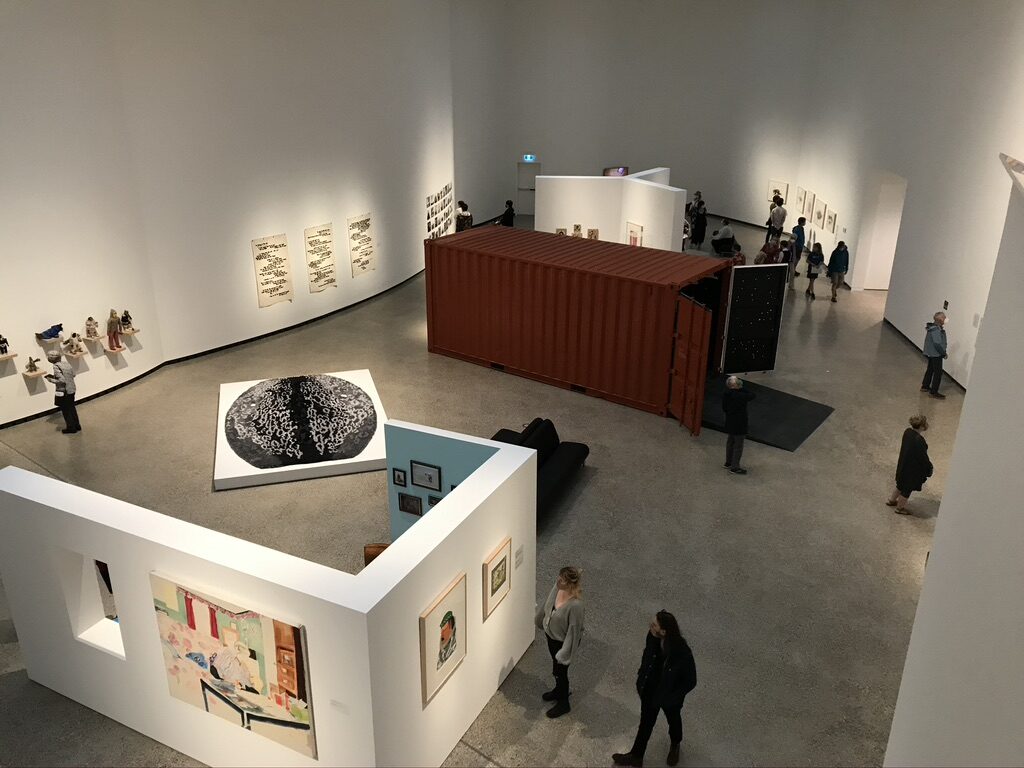
On March 29,2022, members of Museum Queeries participated in a virtual tour of INUA, the inaugural exhibit of Qaumajuq, the new Inuit art centre at the Winnipeg Art Gallery (WAG). The tour was given by Riva Symko, Head of Collections & Exhibitions and Curator of Canadian Art, and Colleen Leduc, Learning & Programs Coordinator. This online tour allowed us to virtually move through the remarkable space, view the fascinating works of art, and even enter some of the immersive pieces. Museum Queeries Research Assistants wrote the following SnapThoughts.
See more on INUA here: https://www.wag.ca/event/inua/
“While the tour of INUA at Qaumajuq wasn’t my first time engaging with the artworks, it was nothing short of a vibrant experience to revisit them. It became apparent that the curators took their time to honour their connections and responsibilities to community, not only through the ancestral objects displayed at the beginning of the exhibition, but also through the amalgamation of what may be considered “traditional” and “contemporary” visual culture. In doing so, they rejected notions of gendered art, such as “craft” and instead depicted a dissolution of time, binaristic thinking, and coloniality. This exhibition gives a nod to the diverse experiences of Inuit art in an intentional and committed manner, demonstrating their affinity and care for their distinct communities.” – Adrienne Huard
“The INUA tour gave me insight on the artists that are held in that gallery space. The occupying of space that INUA does is changing what a gallery space can look like as well as how to utilize a space so that it allows all the works to be in conversation with another. In particular, the tour made me think about how the motorcycle and the house within INUA speak to one another and what dialogue is being had in this room where those two exist within each other’s presence. This exhibition gives artists, curators, archivists, and cultural workers a chance to reimagine how they can create a welcoming environment, especially since this show is presenting not only Inuit art but also the multifaceted identity of Inuit people. It is really clear that this show was orchestrated in an intentional way that allowed the curators to experiment and to give the artists autonomy.” – Mahlet Cuff
“As someone who saw INUA once before but unguided, I appreciated hearing more about the history behind the chosen pieces we were shown. There was an anecdote that felt significant to me about an experience one of the curators shared. Our guide said that, during a virtual tour, she was showing the doll display to a school up north. The participants recognized one of the dolls as being created by someone they all knew who I believe worked at the school. They managed to get the artist to join in on the tour and the artist explained how this was the first doll she ever made. Clearly, it was very special to her. The artist asked the guide to show different aspects of the doll, like its movement, but the guide was unable to due to the (understandable) restrictions around handling the pieces. What I found interesting about this was that though the doll was created for play and interaction, the museum’s ownership of the donated item made it no longer able to serve its intended purpose, even as the Inuit artist herself was requesting the guide to show the specific parts that were important to her so her friends may experience them as well. I believe this is a great example we can use when critically thinking about who the museum is for, and how the institution can show respect not just for the property they have acquired but also for the artists and communities who created it.” – Sav Jonsa
“The end of our online INUA tour made me rush to get tickets to finally see the show in real life! Even though the INUA tour was held online, I really felt the tenderness and joy that came through multiple pieces in the gallery. I felt this while looking at the four videos playing in the gallery’s cabin installation called My Little Corner of Canada. Then I felt it from the two artists, Glenn Gear and Jesse Tungilik, who referenced each other in the museum space. I also really enjoyed hearing the personal stories behind some of the dolls that were put on display in the first floor of the gallery. At the end of the tour, I was curious to see the pieces that were impossible to fully experience online, like Glenn Gear’s “Iluani/Silami,” a shipping container that includes other sensorial aspects that were lost during the online tour. I was also curious to experience the gallery space itself, and what it might feel like to wander through its tall ceilings and open white spaces, and whether that changes my first impressions of the gallery at all.” – Mika Castro
